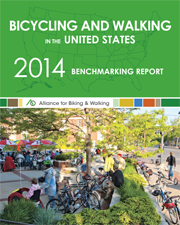 In conjunction with the Centers for Disease Control and Prevention’s Healthy Community Design Initiative, the Alliance for Biking and Walking publishes the biennial Benchmarking Report to collect and analyze data on bicycling and walking in all 50 states, the 52 largest U.S. cities, and a select number of midsized cities. The Report combines original research with over 20 government data sources to compile data on bicycling and walking levels and demographics, safety, funding, policies, infrastructure, education, public health indicators, and economic impacts. It’s an essential go-to resource for public officials, advocates, decisionmakers, and researchers.
In conjunction with the Centers for Disease Control and Prevention’s Healthy Community Design Initiative, the Alliance for Biking and Walking publishes the biennial Benchmarking Report to collect and analyze data on bicycling and walking in all 50 states, the 52 largest U.S. cities, and a select number of midsized cities. The Report combines original research with over 20 government data sources to compile data on bicycling and walking levels and demographics, safety, funding, policies, infrastructure, education, public health indicators, and economic impacts. It’s an essential go-to resource for public officials, advocates, decisionmakers, and researchers.
For a sneak peek, check out four of the most fascinating facts from the report below.
1. We’re seeing small but steady increases in the number of people biking and walking to work.
The average large American city experienced a 5.9% increase in population from 2000 to 2010 without comparable increases in land mass, and budgets are tight across the board. Both of these factors point to a need to find cost-effective modes of transportation that move people without taking up more space.
2. There are lower bicyclist and pedestrian fatalities where there are more people biking and walking.
There is safety in numbers. In the graph in the report, orange dots represent pedestrian fatality rates — i.e., the number of people who have died while walking as a portion of the number of people who walk to work. The grey line indicates the percentage of the population who bikes to work, and the green line shows correlation between the two.
3. More people tend to bike or walk to work when a city has strong biking and walking advocacy.
In 1996, there were just a handful of state and local biking and walking advocacy organizations and only 10 full time staff working on these issues. Now, there are over 230 state and local biking and walking advocacy groups and over 500 full time staff.
A growing number of concerned citizens are organizing for safer, more accessible streets for walking and bicycling.
And there is a positive correlation between the number of people who bike and walk to work in a city and the incomes and staff sizes of those cities’ biking and walking advocacy organizations.
4. A large percentage of commuters bike and walk to work in Alaska, Oregon, Montana, New York, and Vermont.
Not so much in South Carolina, Atlanta, Mississippi, Tennessee, and Texas.
Think this is interesting? Download your copy of the 2014 Benchmarking Report here.
Source: Bikewalkalliance.org
April 21, 2014
http://bikewalkalliance.org










